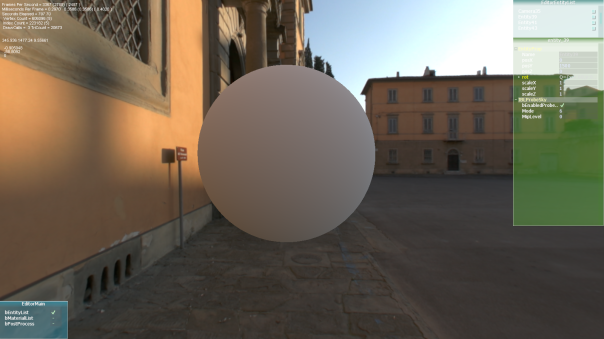Category Archives: JustAnotherGameEngine
New Engine (JAGE5) from scratch

Started next iteration of JustAnotherGameEngine – JAGE5 from scratch. Working with DirectX12 for now and if it ever reaches a good feature-rich point I might look into Vulkan and other platforms. Embracing new cool features of C++ 14/17/20 as well. I did not get the chance to experiment with the new C++ feature set yet. This time another objective is to go multi-threaded as soon as the renderer reaches a certain point – like it should be able to render scenes from fbx, etc, with basic lighting & other common features.
Embracing 3rd party open source libraries and middle-ware a bit more this time to get the new engine up and running as soon as possible. Still going to try to maintain a balance because I want to make a game engine not assemble it and the plan is to code everything on the rendering side myself.
Check out JAGE5 page for more details and also to check out its current progress.
Volumetric Lighting : SunShafts
One of the very popular volumetric lighting effect is SunShafts or volumetric sun shadows or god rays.
An example from real world (image taken from Wikimedia) –

Here’s a screenshot from a video game – Crysis. It was the first game (for me) in which I saw SunShafts –

WIP: Spherical Harmonics
Working on a spherical harmonics maths code base to be used in lighting in my engine in near future.
It’s been quite a while since I worked on my engine ( or any other hardcore stuff for that matter ). I thought working on some maths stuff would be a nice way to resume engine development.
Some screenshots of spherical harmonics visualizations generated from my code base –
Update – Uploaded wrong screenshots by mistake before so updated the screenshots.
Image Based Lighting
Image Based Lighting is used to implement ambient lighting for dynamic objects coming from static objects in a game level. In most cases, it is used for specular lighting or reflections. In this process lighting information at the potential point of interests is stored in a special type of cube maps called Light probes. These Light probes are created using environment maps captured at same locations, which are then blurred in some special way depending on the BRDF [1] that will consume them at runtime. Each mipmap of a light probe contains a version of environment map blurred by a different amount depending roughness represented by that level. For example, if we are using 10 mip map levels to represent roughness from 0 to 1, then mip-0 will be blurred by a value representing roughness 0, mip-1 will represent 0.1 and so on. The last mip level mip-10 will be blurred by a value represent the roughness of 1.0. This process is also called Cubemap Convolution [4][5]. All of this is done as a pre-process and resulting light probes are fetched at runtime to enable reflections or Image Based Lighting.
WIP : Image Based Lighting
From past few weeks, I have been working on Image Based Lighting. Finally, I have finished writing features to generate dynamic cube maps and generate pre-convoluted probes for both diffuse (lambert) and GGX based specular.
Still there’s a lot of work to do. Here’s some rough list of features(or problems) I will be working on next:
- Support for many IBL probes – I am thinking maybe 32
- Choosing IBL probe (probes) to be used for the current pixel being shaded – I am thinking to maybe implement something similar to point light selection using tiled rendering or something. I can just replace point light calculation with cube map sampling for IBL. This way I can store all probes in a single array can bind all IBL probes to the single slot. I think this would be faster than checking the closest IBL probe for every object and passing it while shading. (Same benefits as deferred rendering over forward)
- Parallax correction for local probes
- Realtime IBL probes? – I don’t know if I would need this or SSR would be good enough.
- Fix seams for lower MIP levels. I am not sure whether I should implement parabolic maps or code some other techniques like wrap, or something.
- Improve Pre-convolution performance by further randomizing the samples and use less number of samples.
HDR Rendering – Tonemapping and Bloom
I have been experimenting with tone mapping from a long time. I tried many different ways of implementing tonemapping & bloom and now I have finalized this feature in the engine.
Tone mapping is a technique used in image processing and computer graphics to map one set of colors to another to approximate the appearance of high dynamic range images in a medium that has a more limited dynamic range.
I tried few different Global tone mapping operators with various ways to calculate scene luminance.I tried 3 major approaches (with a lot of variations in between) –
Method 1
In the first approach, I calculated scene luminance by averaging log luminance values of HDR render target of the scene. I did this by rendering a screen space quad calculating log luminance values for the scene and then I used GenerateMips to average them automatically for me. I tried some different tone mapping operators including Reinhard, filmic curve and modified filmic curve (or uncharted2’s filmic curve). At the end modified filmic curve with the ability to modify the curve as need turned out to be the best approach for tone mapping operator.Problem with this method is any few extreme dark/bright spots in the scene can make the whole scene look brighter or darker beyond desired ranges.




































